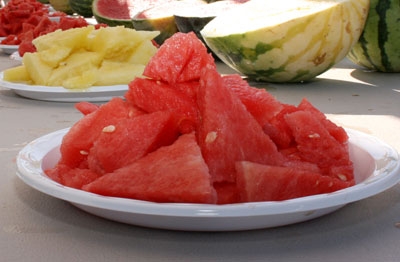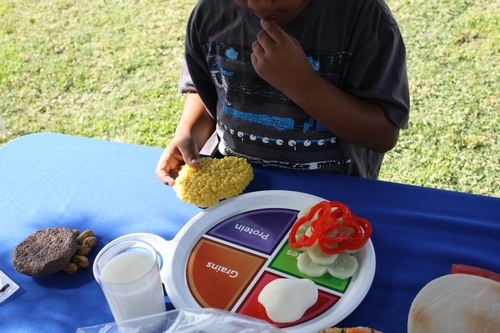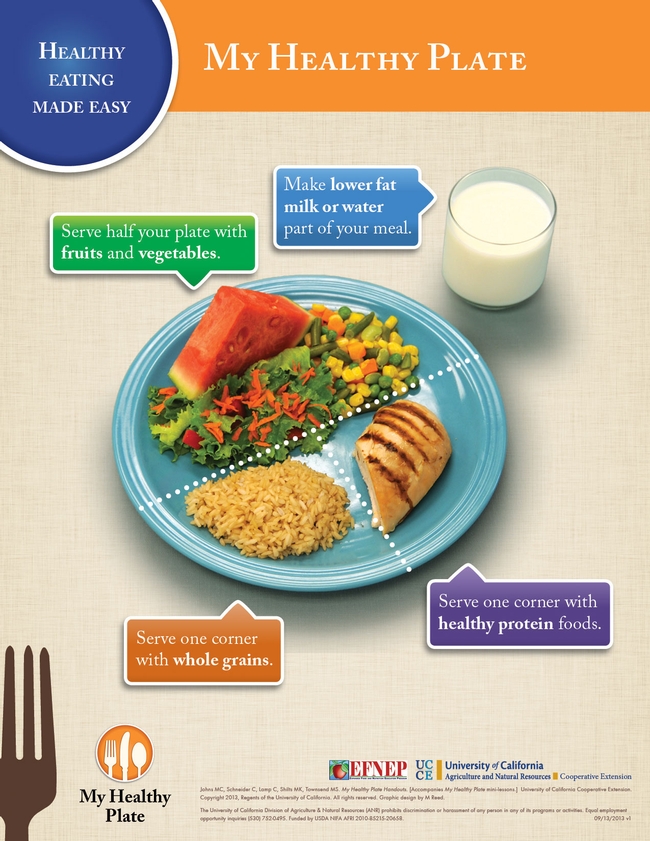Posts Tagged: Cathi Lamp
Unappealing tap water in immigrant communities may deter healthy drink choices
Having established a link between obesity and sugary beverages, doctors and nutritionists recommend that children instead drink plain tap water. In virtually all of the United States and California, tap water is the best drink available for good health.
However, a team of UC Cooperative Extension and UC Davis scientists have found that low-quality tap water in some rural immigrant communities could be an obstacle to making this healthy dietary change.
The study was conducted in conjunction with a five-year research and outreach project underway in Firebaugh and San Joaquin, small communities in the San Joaquin Valley with high Mexican-American populations. The researchers are investigating whether a community-based intervention – involving nutrition education, a monthly voucher of $25 to purchase fruit and vegetables, and a physical activity program – can help prevent childhood obesity in Californians of Mexican descent living in low-income rural communities. UC Agriculture and Natural Resources and UC Davis were recipients of a $4.8 million National Institute for Food and Agriculture grant to carry out this research.
Twenty-seven mothers in the study shared with the researchers whether they use tap water and gave their perceptions of tap water quality. In addition, the researchers assessed local water quality by the frequency of violations reported by Cal EPA and contaminant-level data from the California Department of Public Health.
All 27 mothers said they avoid drinking tap water due to unpleasant taste, dirty or yellow appearance, excessive iron or general “contamination.” Most of the women rely instead on bottled, and to a lesser extent, home filtered water for drinking and cooking.
“This cost is an extra burden for these families, many of whom have limited incomes,” said Lucia Kaiser, UCCE specialist in the Department of Nutrition at UC Davis.
The mothers shared in interviews that at least 38 percent of their children aged 3 to 8 years old drank sugar-sweetened beverages – such as soda, energy drinks, powered drink mixes or fruit punch – more than two or three times per week.
Two state-regulated water systems serve the majority of people in Firebaugh and San Joaquin. The rest rely on at least 11 small public or private systems. All of the 13 systems have had monitoring violations in the last 12 years. Two have had reporting violations, indicating that they either did not test for contaminants or did not report their findings.
The mothers' perception that tap water was unappealing or contaminated was confirmed when the researchers took a close look at regulatory analyses reports from previous years. There were low-levels of arsenic detected, which fell above the benchmark for safe drinking water in the U.S. The analyses also detected high levels of manganese and iron, which are considered secondary contaminants and do not have enforceable limits set by the EPA. However, the World Health Organization has set health benchmarks for manganese, which were exceeded in some samples.
“The neurotoxic effects of manganese and chronic exposure to low levels of arsenic warrant further study,” Kaiser said. “Even if it's not dangerous, the high level of manganese and iron can give the water an off taste.”
Regardless, removing the contaminants may not matter if perceptions and drinkability are not improved. A possible solution is better communication.
“A simple step could be sending easy-to-understand water quality reports to all residents,” Kaiser said. “Sending reports to renters in addition to property owners and in Spanish as well as English will help raise awareness about the safety of local tap water.”
The study was funded in part by the UC Davis Center for Poverty Research, which developed a two-page policy brief outlining the research findings. UC Davis doctoral student Caitlin French was the main author. Other contributors, in addition to Kaiser, were post-doctoral researcher Rosa Gomez-Camacho, UCCE nutrition, family and consumer sciences advisor Cathi Lamp and UC Davis nutrition professor Adela de la Torre.
In the policy brief, the authors included some additional suggestions to address the issue:
- Increase state funds to agencies working to identify who is at risk in order to bring more water systems into compliance
- Provide subsidies for home water filters
- Provide subsidies to private well owners in exchange for testing reports
- Step up outreach to owners of targeted private water systems in known problem areas
- Provide funding for additional research to inform outreach messages about substituting tap water for sugar-sweetened beverages
An initiative to maintain and enhance healthy families and communities is part of the UC Division of Agriculture and Natural Resources Strategic Vision 2025.
Picture this: UCCE focuses on healthy meals for Healthy Weight Week (Jan. 18-24)
Photos of sumptuous dishes are nearly as numerous as cat photos on social media. To sharpen people's focus on healthful eating, UC Cooperative Extension nutrition experts are using photos of food.
In 2011, the U.S. Department of Agriculture unveiled a new food graphic, MyPlate, to remind consumers to choose healthier foods. Work by Cooperative Extension in California that began years earlier influenced the adoption of MyPlate by USDA. Nutrition educators in California began using a plate graphic with USDA's My Pyramid several years ago in a research project with Expanded Food and Nutrition Education Program (EFNEP) and UC CalFresh Nutrition Education Program participants. While evaluating the use of their graphic, which was very similar to USDA's MyPlate, UC Cooperative Extension nutrition advisors found that a graphic depiction such as the one USDA is using for MyPlate is abstract for many families.
“We discovered that our clients need to see photos showing real food combinations in order to apply the MyPlate message to real food choices,” said Cathi Lamp, UC Cooperative Extension nutrition advisor. “They prefer to learn by viewing photographs with foods and meals they eat to see how it works and how they can implement the guide in their lives.”
In a project with more than 200 Latino consumers participating, the UCCE nutrition advisors learned which foods Latina, African American and other women would serve their families. Lamp and her colleagues developed materials with photographs of the preferred foods for nutrition education.
They evaluated the behavior of consumers who were trained with the revised Plan, Shop, Save and Cook curriculum with photos of food and compared it with the results of the original version of the lessons.
“We found that the group receiving the revised Plan, Shop, Save and Cook and MyPlate materials reported the greatest change in the frequency of using MyPlate to make food choices, after considering differences among groups in initial behaviors and participant characteristics,” Lamp said.
Given the success of the photographs, UC Cooperative Extension created “My Healthy Plate” posters. Photographs of healthful food served on plates appear in all the EFNEP and UC CalFresh nutrition education materials, including the revised Plan, Shop, Save and Cook curriculum.
“Everybody enjoys looking at pictures of foods,” said Lamp. “So what we have now in our nutrition classes are lots of photographs of healthy examples.”
To listen to an interview with Cathi Lamp about My Healthy Plate in Spanish, visit Enseñando a comer ‘con sabor latino' con MiPlato at http://ucanr.edu/sites/Spanish/Noticias/radio/?uid=5983&ds=199.
For more than 100 years, the University of California Cooperative Extension researchers and educators have been drawing on local expertise to conduct agricultural, environmental, economic, youth development and nutrition research that helps California thrive. UC Cooperative Extension is part of the University of California's systemwide Division of Agriculture and Natural Resources. Learn more at ucanr.edu.
Food banks in Fresno and Tulare consider merger
The Visalia Times-Delta reported that UC Cooperative Extension was one of the organizations represented at a meeting about the potential merger last Friday, which also included Kaweah Delta Healthcare District, Pixley-based Be Healthy Tulare and United Way of Tulare County.
“I guess one of my fears is there is an inherent distrust of Fresno,” the story quoted Cathi Lamp, nutrition, family and consumer sciences advisor for UCCE in Tulare County and a former FoodLink board member. Lamp said she is concerned the merged food bank would be based in Fresno County, and Tulare County's needs might be ignored.
Julie Cates, UCCE nutrition program coordinator, told me FoodLink of Tulare County has long focused on distributing quality, nutrient dense products and partnering with agencies, such as UCCE, to provide nutrition education.
"We were able to have our teachers at the school receiving the 'farmers market' write testimonial emails and one teacher submitted letters from the fourth-grade students," Cates said. "I am very pleased with this outcome, as it illustrates how the food distributions are migrating from the inner to outer circles of the social ecological model in which we are striving to serve, reflecting universal behavior change."
View a one-minute video about one of the collaborative projects conducted by FoodLink of Tulare County and UCCE Tulare County:
The weight of the nation
UC Cooperative Extension in Tulare County offers a free screening of a film that addresses the increasing level of overweight and obesity in the United States, reported the Visalia Times-Delta.
The film, titled “Children in Crisis,” is the third part of the HBO series “The Weight of the Nation." The film will show at 1 p.m. Friday, Sept. 21, at the Agriculture Building Auditorium, 4437 S. Laspina St., Tulare.
Obesity is an on-going issue in Tulare County, Cathi Lamp is quoted in the article. Lamp is the UC Cooperative Extension advisor in Tulare County for nutrition, family and consumer sciences.
She is no stranger to the health issues that plague the county’s children. Lamp has been part of campaigns to stop people from drinking sugary drinks and to encourage healthful eating habits as well as incorporate physical activity into their lives, the article said.
Eating right doesn’t have to break the budget
Even though dietitians have for decades strongly recommended eating lots of fruit and vegetables daily, very few Americans hit the mark. Food prices, taste, inconvenience, and a failure to understand the link between diet and health have been blamed for Americans’ poor food choices.
New research by the USDA Economic Research Service dispels one of those obstacles. The study determined that buying the recommended amount of fruits and vegetables costs on average only $2 to $2.50 per day.
“For those with access and the means to buy them, the assertion that fruits and vegetables are too expensive is not a good excuse,” said UC Cooperative Extension nutrition, family and consumer sciences advisor Cathi Lamp. “Consumers should be able to purchase a days’ worth of fruit and vegetables for less than it costs to buy a cheeseburger.”
The ERA researchers estimated the average retail prices of 153 fresh and processed fruits and vegetables. Processed fruits and vegetables included frozen, canned and dried plus 100 percent fruit juice. They also estimated the average price per edible cup for each vegetable and fruit.
Costs in the study were defined as the average prices paid by all American households for a food over a one-year period, including purchases in different package sizes, under different brand names and at different types of retail outlets (including supercenters such as Wal-Mart, wholesale club stores like Costco, traditional grocery stores such as Safeway, Kroger and Albertsons, and convenience stores.)
The research indicated that:
- Fruits and vegetables cost about 50 cents per edible cup.
- The lowest average price for any of the 59 fruits in the study was for fresh watermelon, at 17 cents per cup. The highest average price was for fresh raspberries, at $2.06 per cup.
- Among the 95 fresh and processed vegetables in the study, a cup of dry pinto beans was the least expensive at 13 cents. The most expensive was frozen asparagus cuts and tips at $2.07 per cup.
- Processed fruits and vegetables were not consistently more or less expensive than fresh produce, but with certain types of produce, the prices varied quite a bit. Canned carrots, at 34 cents per cup, were more expensive than fresh carrots, at 25 cents per cup. However, canned peaches, at 58 cents per cup, were less expensive than fresh, at 66 cents per cup.
Lamp suggested smart shopping can also help consumers reduce the cost of their fruits and vegetables. For example, buy fresh fruit and vegetables in season, use canned and frozen fruit and vegetables when it is cheaper and stock up when items are on sale or when shopping at a supercenter or wholesale club.

USDA says fresh watermelon is, on average, the least expensive fruit.








